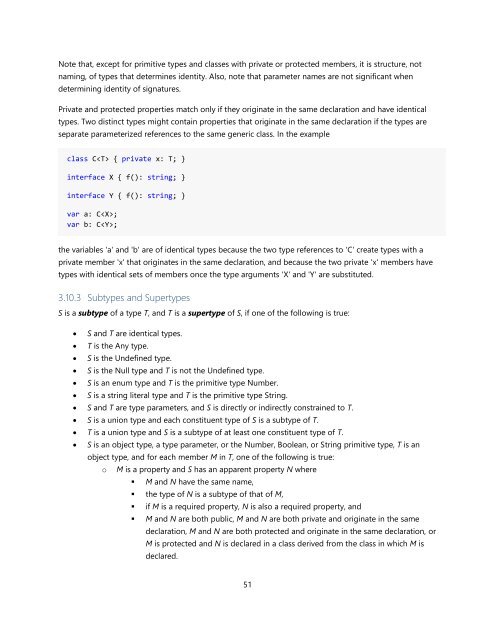TypeScript Language Specification v1.5
TypeScript Language Specification v1.5
TypeScript Language Specification v1.5
Create successful ePaper yourself
Turn your PDF publications into a flip-book with our unique Google optimized e-Paper software.
Note that, except for primitive types and classes with private or protected members, it is structure, not<br />
naming, of types that determines identity. Also, note that parameter names are not significant when<br />
determining identity of signatures.<br />
Private and protected properties match only if they originate in the same declaration and have identical<br />
types. Two distinct types might contain properties that originate in the same declaration if the types are<br />
separate parameterized references to the same generic class. In the example<br />
class C { private x: T; }<br />
interface X { f(): string; }<br />
interface Y { f(): string; }<br />
var a: C;<br />
var b: C;<br />
the variables 'a' and 'b' are of identical types because the two type references to 'C' create types with a<br />
private member 'x' that originates in the same declaration, and because the two private 'x' members have<br />
types with identical sets of members once the type arguments 'X' and 'Y' are substituted.<br />
3.10.3 Subtypes and Supertypes<br />
S is a subtype of a type T, and T is a supertype of S, if one of the following is true:<br />
S and T are identical types.<br />
T is the Any type.<br />
S is the Undefined type.<br />
S is the Null type and T is not the Undefined type.<br />
S is an enum type and T is the primitive type Number.<br />
S is a string literal type and T is the primitive type String.<br />
S and T are type parameters, and S is directly or indirectly constrained to T.<br />
S is a union type and each constituent type of S is a subtype of T.<br />
T is a union type and S is a subtype of at least one constituent type of T.<br />
S is an object type, a type parameter, or the Number, Boolean, or String primitive type, T is an<br />
object type, and for each member M in T, one of the following is true:<br />
o M is a property and S has an apparent property N where<br />
• M and N have the same name,<br />
• the type of N is a subtype of that of M,<br />
• if M is a required property, N is also a required property, and<br />
• M and N are both public, M and N are both private and originate in the same<br />
declaration, M and N are both protected and originate in the same declaration, or<br />
M is protected and N is declared in a class derived from the class in which M is<br />
declared.<br />
51


















